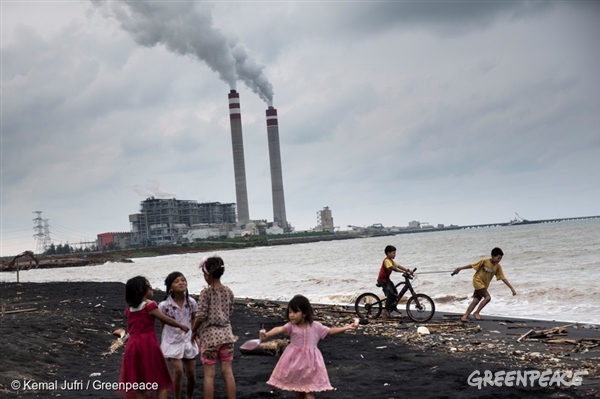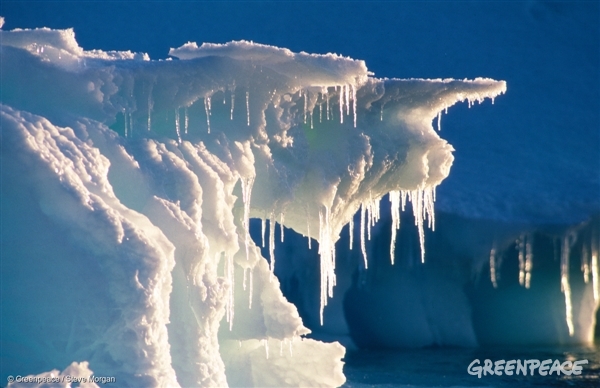World scientists’ warning to humanity
Environmental activists and organisations typically try and stay positive, to give people hope that we can change. Positive signs exist, going back to the historic whaling and toxic dumping bans of the 1980s. The 1987 Montreal Protocol, reducing CFC gas emissions, led to a partial recovery of the ozone hole. Birth rates have declined in some regions, and forests and freshwater have been restored in some regions. The world's nations have, at least, made promises to reduce carbon emissions, even if action has been slow.
A challenge we face as ecologists and environmentalists, however, is that when we step back from our victories and assess the big picture - the global pace of climate change, forest loss, biodiversity decline - we must admit: our achievements have not been enough.
Children playing near a coal plant in Central Java
25 years ago, in 1992, the Union of Concerned Scientists issued the “World Scientists’ Warning to Humanity” signed by 1,700 scientists, including most living Nobel laureates. They presented disturbing data regarding freshwater, marine fisheries, climate, population, forests, soil, and biodiversity. They warned that “a great change" was necessary to avoid "vast human misery.”
This year, on the 25th anniversary of that warning, the Alliance of World Scientists published a second warning - an evaluation of our collective progress. With the exception of stabilising ozone depletion, they report that "humanity has failed to make sufficient progress in generally solving these foreseen environmental challenges, and alarmingly, most of them are getting far worse."
A short history of warnings
Environmental awareness is not new. Over 2,500 years ago, Chinese Taoists articulated the disconnect between human civilisation and ecological values. Later Taoist Bao Jingyan warned that "fashionable society goes against the true nature of things… harming creatures to supply frivolous adornments.”
Modern warnings began in the 18th century, at the dawn of the industrial age, particularly from Thomas Malthus, who warned that an exponentially growing population on a finite planet would reach ecological limits. Modern growth advocates have ridiculed Malthus for being wrong, but his logic and maths are impeccable. He did not foresee the discovery of petroleum, which allowed economists to ignore Malthus for two centuries, aggravating the crisis that Malthus correctly identified.
Rachel Carson ignited the modern environmental movement in 1962 with Silent Spring, warning of eminent biodiversity collapse. A decade later, in the early days of Greenpeace, the Club of Rome published The Limits To Growth, using data to describe what we could see with our eyes: declining forests and biodiversity, and resources, clashing head-on with growing human population and consumption demands. Conventional economists mocked the idea of limits, but The Limits to Growth projections have proven accurate.
In 2009, in Nature journal, a group of scientists lead by Johan Rockström published Planetary Boundaries, warning humanity that essential ecological systems – biodiversity, climate, nutrient cycles, and others – had moved beyond ecological limits to critical tipping points.
Melting iceberg in the Southern Ocean
Three years later, 22 international scientists published a paper called ‘Approaching a State Shift in Earth’s Biosphere’ which warned that human growth had “the potential to transform Earth... into a state unknown in human experience.” Canadian co-author, biologist Arne Mooers lamented, “humans have not done anything really important to stave off the worst. My colleagues… are terrified.”
In 2014 Michael Gerst, Paul Raskin, and Johan Rockström published ‘Contours of a Resilient Global Future’ in Sustainability 6, searching for viable future scenarios that considered both the natural limits to growth and realistic targets for human development. They warned that the challenge is "daunting" and that "marginal changes" are insufficient.
Last year, the UN International Resource Panel (IRP), published ‘Global Material Flows and Resource Productivity’ warning nations that global resources are limited, human consumption trends are unsustainable, and that resource depletion will have unpleasant impacts on human health, quality of life, and future development.
This year, the second “World Scientists’ Warning to Humanity,” alerted us again that marginal changes appear insignificant and that we are surpassing "the limits of what the biosphere can tolerate without substantial and irreversible harm."
The data speaks
The Alliance of World Scientists researchers tracked data over the last 25 years, since the 1992 warning. They cite some hopeful signs, such as the decline in ozone-depleting CFC gases, but report that, from a global perspective, our "changes in environmental policy, human behavior, and global inequities... are far from sufficient."
Here’s what the data shows:
Ozone: CFC (chlorofluorocarbons) emissions are down by 68% since 1992, due to the 1987 UN Montreal Protocol. The ozone layer is expected to reach 1980 levels by mid-century. This is the good news.
Freshwater: Water resources per capita have declined by 26% since 1992. Today, about one billion people suffer from a lack of fresh, clean water, "nearly all due to the accelerated pace of human population growth" exacerbated by rising temperatures.
Fisheries: The global marine catch is down by 6.4% since 1992, despite advances in industrial fishing technology. Larger ships with bigger nets and better sonar cannot catch fish that are not there.
Ocean dead zones: Oxygen-depleted zones have increased by 75 %, caused by fertilizer runoff and fossil-fuel use. Acidification due to carbon emissions kills coral reefs that act as marine breeding grounds.
Forests: By area, forests have declined by 2.8% since 1992, but with a simultaneous decline in forest health, timber volume, and quality. Forest loss has been greatest where forests are converted to agricultural land. Forest decline feeds back through the ecosystem as reduced carbon sequestration, biodiversity, and freshwater.
Biodiversity: Vertebrate abundance has declined 28.9 %. Collectively, fish, amphibians, reptiles, birds, and mammals have declined by 58% between 1970 and 2012. This is harrowing.
CO2 emissions: Regardless of international promises, CO2 emissions have increased by 62% since 1960.
Temperature change: The global average surface temperature is increasing in parallel to CO2 emissions. The 10 warmest years in the 136-year record have occurred since 1998. Scientists warn that heating will likely cause a decline in the world’s major food crops, an increase in storm intensity, and a substantial sea level rise, inundating coastal cities.
Population: We’ve put 2 billion more humans on this planet since 1992 - that’s a 35 % increase. To feed ourselves, we’ve increased livestock by 20.5 %. Humans and livestock now comprise 98.5% of mammal biomass on Earth. The scientists stress that we need to find ways to stabilise or reverse human population growth. "Our large numbers," they warn, "exert stresses on Earth that can overwhelm other efforts to realise a sustainable future"
Soil: The scientists report a lack of global data, but from national data we can see that soil productivity has declined around the world (by up to 50% in some regions), due to nutrient depletion, erosion, and desertification. The EU reports losing 970 million tonnes of topsoil annually to erosion. The US Department of Agriculture estimates 75 billion tons of soil lost annually worldwide, costing nations $400 billion (€340 billion) in lost crop yields.
The pending question
"We are jeopardising our future by not reining in our intense but geographically and demographically uneven material consumption," the scientists warn, "and by not perceiving ... population growth as a primary driver behind many ecological and societal threats.”
The Alliance of World Scientists report offers some hope, in the form of steps that we can take to begin a more serious transition to sustainability:
- Expand well-managed reserves - terrestrial, marine, freshwater, and aerial - to preserve biodiversity and ecosystem services.
- Restore native plant communities, particularly forests, and native fauna species, especially apex predators, to restore ecosystem integrity.
- End poaching, exploitation, and trade of threatened species.
- Reduce food waste and promote dietary shifts towards plant-based foods.
- Increase outdoor nature education and appreciation for children and adults.
- Divest from destructive industries and invest in genuine sustainability. That means phasing out subsidies for fossil fuels, and adopting renewable energy sources on a large scale.
- Revise economic systems to reduce wealth inequality and account for the real costs that consumption patterns impose on our environment.
- Reduce the human birth-rate with gender-equal access to education and family-planning.
These proposed solutions are not new, but the emphasis on population is important, and often overlooked. Some environmentalists avoid discussing human population, since it raises concerns about human rights. We know that massive consumption by the wealthiest 15% of us is a fundamental cause of the ecological crisis. Meanwhile, the poorest individuals consume far less than their fair share of available resources.
Aftermath of Typhoon Haiyan in the Philippines
As an ecologist, I feel compelled to ask myself: if the last 50 years of environmental action, research, warnings, meetings, legislation, regulation, and public awareness has proven insufficient, despite our victories, then what else do we need to do?
That question, and an integrated, rigorous, serious answer, needs to be a central theme of the next decade of environmentalism.
Resources and Links:
World Scientists’ Warning to Humanity: A Second Notice; eight authors and 15,364 scientist signatories from 184 countries; BioScience, W.J. Ripple, et. al., 13 November 2017
List of 15,364 signatories from 184 Countries: Oregon State University
Alliance of World Scientists: Oregon State University
Recovery of Ozone depletion after Montreal Protocol: B. Ewenfeldt, "Ozonlagret mår bättre", Arbetarbladet 12 September, 2014.
Fertility rate reduction in some regions: UN
Accuracy of Limits to Growth Study: "Is Global Collapse Imminent? An Update to Limits to Growth with Historical Data," Graham Turner, 2014): Melbourne Sustainable Society Institute
“Contours of a Resilient Global Future,” Michael Gerst, Paul Raskin, and Johan Rockström, Sustainability 6, 2014.
Arithmetic, Population, and Energy: Albert Bartlett video lecture on exponential growth
William Rees, The Way Forward: Survival 2100, Solutions Journal, human overshoot and genuine solutions.
Johan Rockström, et. al., “Planetary Boundaries,” Nature, September 23, 2009.
Anthony D. Barnosky, et. al., “Approaching a state shift in Earth’s biosphere,” Nature, June 7, 2012.



